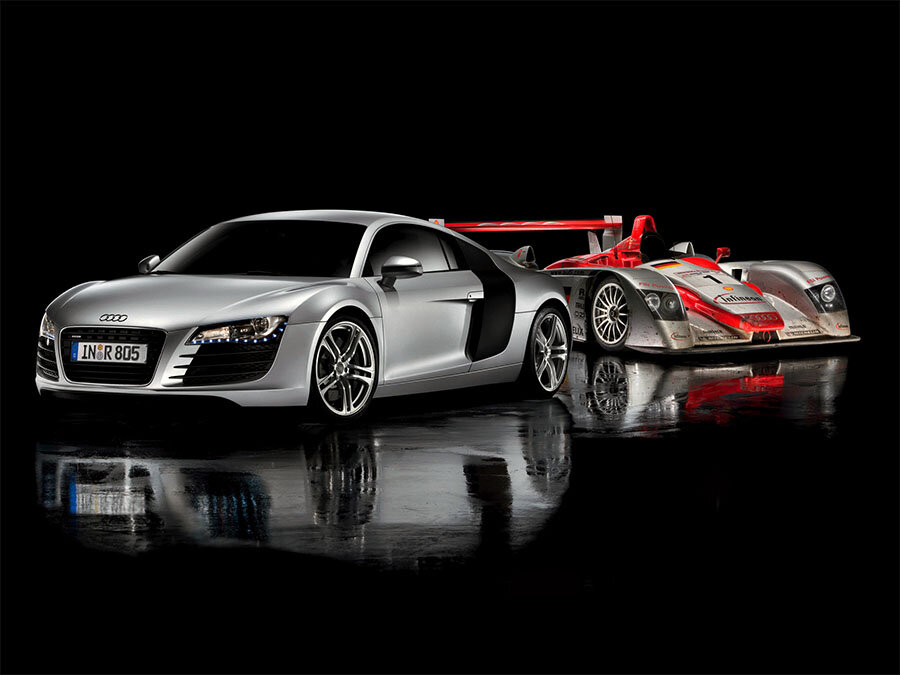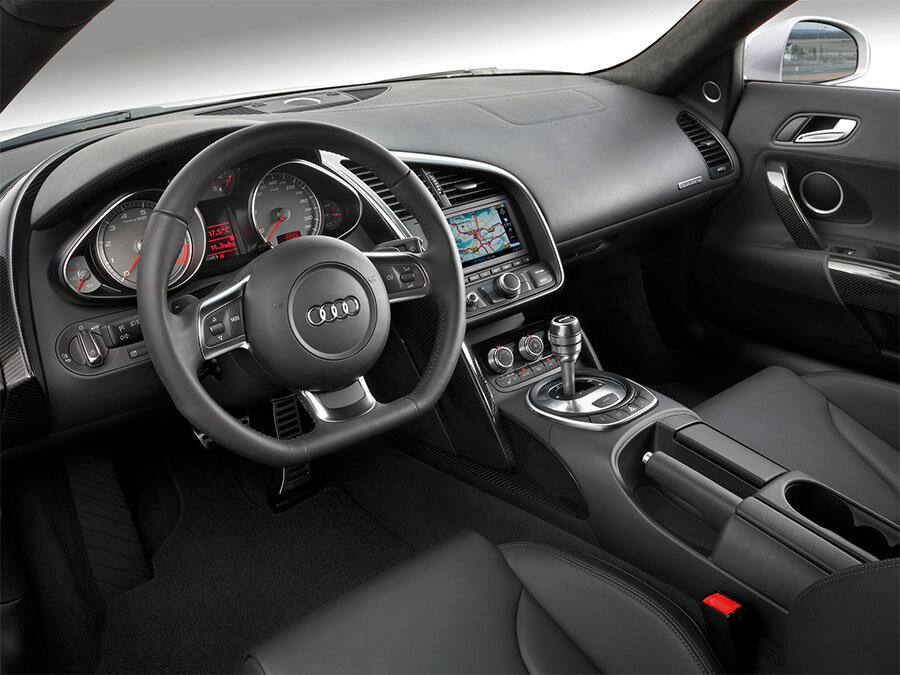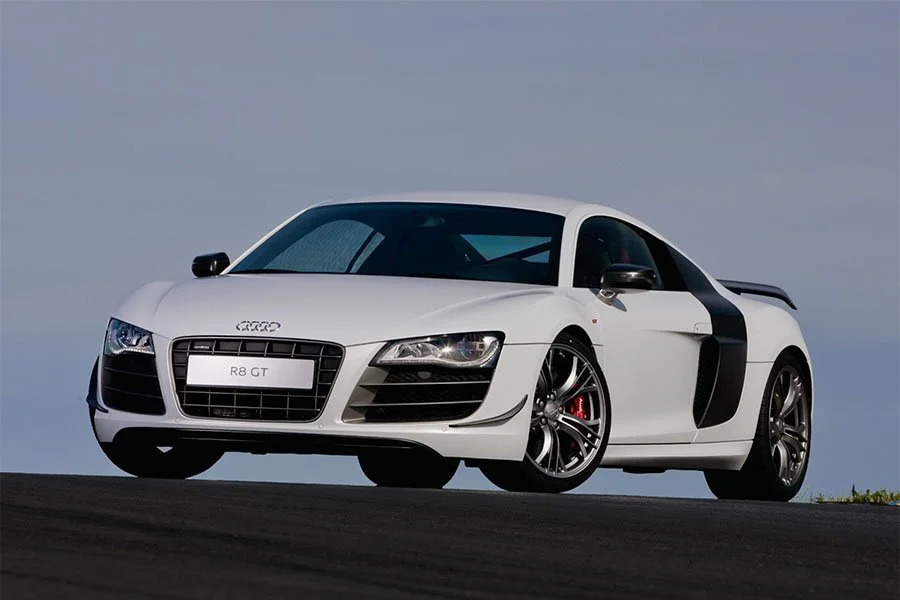Guide: Audi R8 (Type 42) - a Historical & Technical Appraisal
/BACKGROUND
By the early 2000s, Audi’s transformation to builder of prestige automobiles that could rival BMW and Mercedes-Benz was almost complete.
Considerable progress had been made in terms of the brand’s status thanks to the original Quattro model produced between 1980 and 1991. As a result of its highly capable four-wheel drive platform, handsome looks and rally pedigree, the expensive Quattro became an icon of its era.
After Quattro production ended, Audi ushered in a new line of S and RS-badged high performance models to capitalise on the company’s new found sporting credentials. The S and RS line mostly comprised Saloon and Estate-bodied iterations of existing models.
The compact two-door TT then followed in 1998 and proved a massive commercial success.
Meanwhile, throughout the 1980s and 1990s, Audi’s motor sport programmes had predominantly focused on rallying and touring car racing. Even the highly successful IMSA GTO campaign of 1989 had used production-based 90 styling for marketing reasons.
It therefore seemed that, with VAG’s acquisition of Lamborghini, Bugatti and Bentley in 1998, Audi were destined not to take the final step into elite performance car territory, either with a production model or in motor sport.
However, behind the scenes, management had sanctioned a move into top flight sports car racing for the 1999 season.
Audi subsequently headed to Le Mans with the R8 LMP900 class machine in 2000 and won the 24 hour race first time out.
Further victories followed in 2001 and 2002. In 2003, sister company Bentley took the laurels.
To make the most of their endurance racing success, at the Frankfurt Motor Show in September 2003 Audi unveiled a two-seat mid-engined supercar with permanent four-wheel drive and a 600bhp V10 engine. Dubbed the Le Mans Quattro Concept, it was based on the new Lamborghini Gallardo which had itself been launched at the Geneva Motor Show six months earlier.
The response to Audi’s stunning debutant was so overwhelmingly positive that a production version was immediately given the green light.
Design, development and construction was handled by Audi’s high performance subsidiary, Audi Sport GmbH (formerly known as Quattro GmbH). Assembly would take place at the Neckarsulm plant where the chassis for the Lamborghini Gallardo was created.
After two more victories for Audi’s LMP car at Le Mans in 2004 and 2005, management decided the firm’s new supercar would be named R8 in its honour.
The production R8 was unveiled at the Paris Motor Show on 30th September 2006. Customer deliveries began in early 2007.
CHASSIS
The R8 was based on a stretched version of the Gallardo’s lightweight aluminium spaceframe. Most notably, the wheelbase was extended from by 90mm (to 2650mm) to free up additional cockpit space.
The engine was mounted longitudinally in a carbonfibre cradle.
Independent suspension was via forged aluminium double wishbones all round plus a track rod either side at the rear. Coil sprung gas-filled dampers and anti-roll bars were fitted at either end.
Ventilated discs brakes had a 365mm diameter and eight piston calipers at the front. The rears measured 356mm and ran six piston calipers.
Power-assisted steering was standard along with the Bosch ESP 8.0 Electronic Stability Programme which included anti-lock brakes, electronic brakeforce distribution and traction control.
The 18-inch diameter forged alloy wheels had a five twin-spoke design. Up front they were 8.5-inches wide. Those at the rear were 10.5-inches wide. OEM tyres were Pirelli P Zeros.
Weight distribution was a near perfect 44/56.
Twin fuel tanks with a 75-litre capacity were mounted either side of the engine, up against the rear bulkhead.
ENGINE / TRANSMISSION
At the heart of the R8 was an uprated iteration of Audi’s 4.2-litre BYH engine as fitted to the B7 RS4.
Unlike the RS4 motor, the R8 power unit ran a dry-sump lubrication system that eliminated oil surge.
The BYH engine was a 4.2-litre 90° V8 with dual chain-driven overhead camshafts, four valves per cylinder and Fuel Stratified Injection (FSI) as pioneered on the R8 LMP racing car. Variable valve timing was employed for both the inlet and exhaust camshafts.
The engine’s all-alloy construction included a block formed from ALUSIL (an aluminium-silicon alloy). Silicon crystal liners were also used.
Displacement was 4163cc thanks to a bore and stroke of 84.5mm and 92.8mm respectively.
The compression ratio was 12.5:1.
In this configuration, peak output was 420bhp at 7800rpm and 317lb-ft at 4500-6000rpm (identical figures to the RS4).
A six-speed manual gearbox was standard.
Transmission was through a permanent four-wheel drive system with Electronic Differential Lock (EDL). This distributed up to 70% of the power to the rear axle and 30% to the front.
A six-speed R-Tronic single-clutch automated manual gearbox with paddle shifters was an expensive optional extra and added 5kg of weight.
BODYWORK
The R8’s bodywork was a mixture of aluminium and carbonfibre. Thanks to innovative use of air intakes and the latest lighting technology, it looked quite unlike anything else available at the time.
The nose was home to Audi’s trademark trapezoidal primary intake which housed a central plinth for the licence plate.
Curvaceous LED headlights were housed within the cooling apertures located on either side of the primary intake. These supplementary ducts were equipped with three horizontal blades and a matching black meshed grille.
A similar treatment was applied at the back, under which fully shrouded dual exhausts emerged. The tail was also home to a retractable spoiler and two large diffusers.
Down each flank was a slim vertical cooling duct complete with a distinctive satin black blade. The large arced blade ran from the top of the rear three quarter window down towards the base of the door to give the R8 another of its trademark features.
As there was no trunk at the back of the car, 100-litres of storage space could be found in the nose.
INTERIOR
Inside, it was no surprise to find that Audi lifted much of the R8’s switchgear from other models in the range.
The three-spoke steering wheel had a flat base like several of Audi’s high performance models. Behind it was a curvaceous binnacle that housed all the instrumentation along with a digital read out for various systems.
Large analogue dials for engine and road speed featured inset digital read outs. They were flanked to the left by an oil temperature gauge and to the right by an ammeter. More small instruments for water temperature and fuel were positioned at the top of the binnacle.
The infotainment system was located centrally above the air-conditioning controls.
All round visibility was very good, the cockpit was spacious enough for tall occupants and there was enough storage capacity behind seats for two sets of golf clubs.
Standard equipment included a CD player, digital climate control, electric mirrors, electric windows, heated mirrors, leather upholstery, driver and passenger airbags and a steering wheel that could be adjusted for rake and reach
OPTIONS
Options included state-of-the-art Magnetorheological dampers sourced from Delphi. This advanced suspension system applied an electrical charge to magnetic particles in the damper fluid which enabled the viscosity of the dampers to be changed (and thus stiffened or softened) on the move.
Other cost upgrades included bucket seats, heated seats, carbon disc brakes, a long-range 90-litre fuel tank, fitted luggage, a rear view camera, extended leather, satellite navigation, a CD multichanger, remote audio system, cruise control, a DVD player, electric seats, metallic paint, side airbags and carbonfibre or piano black cockpit inserts.
WEIGHT / PERFORMANCE
The R8 tipped the scales at 1560kg.
Audi quoted a top speed of 187mph and a 0-62mph time of 4.6 seconds for the manual gearbox variant.
Cars equipped with the R-Tronic semi-automatic transmission had a 0-62mph time of 4.9 seconds.
5.2 V10
In December 2008, Audi answered calls for more power by introducing an R8 with a de-tuned version of the FSI V10 used in the Lamborghini Gallardo LP560-4. A similar albeit further downrated unit was also fitted to the Audi S8 (D3).
The specification was much like the smaller V8 engine. However, thanks to its extra pair of cylinders, this latest motor displaced 5204cc.
Bore and stroke stayed at 84.5mm and 92.8mm respectively. Likewise, the compression ratio was 12.5:1.
The R8 V10 produced a peak output of 525bhp at 8000rpm and 391lb-ft at 6500rpm.
In comparison, the Gallardo pumped out 560bhp at 8000rpm and 398lb-ft at 6500rpm.
Other equipment included new-LED headlights, V10 badges on the front fenders, a front grille with fewer bars, twin blade intakes front and rear, a satin black tail fascia and single exhaust outlet per side.
19-inch wheels replaced the original 18-inch diameter rims. The fronts still measured 8.5-inches wide, but the rears were increased from 10.5-inches to 11-inches.
A 90-litre fuel tank was fitted instead of the V8’s 75-litre unit.
Inside, a Bang & Olufsen 465 watt sound system was standard.
Weight went from 1560kg to 1620kg. However, performance was noticeably improved. Top speed rose from 187mph to 196mph. The 0-62mph time dropped from 4.6 seconds to 4.1 seconds.
5.2 V10 SPYDER
Nine months after the V10 engine arrived, Audi revealed an R8 Spyder.
Launched at the Frankfurt Motor Show in September 2009, the Spyder was initially only available with the V10 power unit.
To compensate for the lack of a roof, the R8’s aluminium spaceframe was substantially reinforced which led to a 100kg weight gain (now 1720kg).
Aside from a new electric canvas roof that folded away under a flattened retractable rear deck to disappear completely from view, the R8 Spyder featured a pair of roll over safety bars behind the seats. Additionally, the R8 Coupe’s trademark sideblades were deleted and the fuel filler cap was moved from the right-hand sail panel to the top of the right-hand rear fender.
An 80-litre fuel tank was installed instead of the V10 Coupe’s 90-litre cell.
4.2 V8 SPYDER
From March 2011, the R8 Spyder was available with the 4.2-litre V8 engine.
The technical specification was as per the 5.2-litre V10 variant, albeit with the smaller eight cylinder motor.
Compared to the Coupe, which had a peak output of 420bhp at 7800rpm, the V8 used in the Spyder produced 430bhp at 7900rpm.
The torque rating was unchanged with 317lb-ft at 4500-6000rpm.
4.2 V8 COUPE LIMITED EDITION (UK MARKET)
To celebrate Audi’s tenth victory at the Le Mans 24 Hours, a UK market V8 Coupe Limited Edition was made available from July 2011.
100 were built, all of which came with a very high specification to include titanium finish 19-inch twin-spoke wheels from R8 GT Coupe, Audi’s magnetic ride system and red brake calipers. A Carbon Package comprised carbonfibre sideblades, door mirrors, cockpit inlays, door sill trims and engine bay illumination.
The interior was enhanced with black Nappa leather, red stitching, crimson red leather cockpit inserts plus floormats with crimson red leather edges and silver R8 logos. Additional equipment included satellite navigation, the Audi Music Interface, the interior light package, stainless steel pedals, illuminated door sills, a premium Bang & Olufsen audio system and mobile phone preparation.
5.2 V10 COUPE LIMITED EDITION (CHINESE MARKET)
For the Chinese market, the R8 5.2 V10 Coupe Limited Edition was unveiled at the Guangzhou Motor Show in November 2011.
30 examples were built, all of which came with R-Tronic transmission, Cool Nordic Gold paint, GT spoilers, GT bumpers and the GT’s larger rear diffuser.
Other exterior equipment included air intakes, radiator grilles and lightweight tail pipes in matt black. The tail fascia was titanium grey. Matt carbonfibre was used for the sideblades, exterior mirrors, rear wing and rear diffuser.
The interior was also heavily optioned. The Limited Edition featured bucket seats in black alcantara with contrast trim and piping, an aluminium gear knob with numbered plaque, alcantara headliner and steering wheel rim and a shark skin black knee pad. The centre console, handbrake and door trim inlays were body coloured. Door pulls were matt carbonfibre.
4.2 V8 COUPE & 5.2 V10 COUPE EXCLUSIVE SELECTION EDITIONS (US MARKET)
A batch of limited edition Coupes were built for the US market during 2012.
Audi produced 20 examples of the V8-powered Exclusive Selection Edition and another 30 with the V10 motor.
The V8 model came with matt Daytona Grey paint, 19-inch titanium finish double spoke wheels, a carbonfibre front splitter and rear diffuser, R8 GT tail lamps, black grille surrounds, black exhausts and red brake calipers.
Inside, Audi bundled an exclusive leather package with crimson red inserts and contrast stitching, a Bang & Olufsen audio system, satellite navigation, the Audi Music Interface, a leather navigation surround, a thicker contoured leather multifunction steering wheel and carbonfibre cockpit inserts.
The V10 came with all of the V8 equipment, but was painted Ibis white with Brilliant Black used for the sideblades, exterior mirrors, rear licence plate shroud and 19-inch bi-colour e-tron wheels. The interior featured Alabaster White contrast stitching and inserts.
5.2 V10 COUPE CHINA EDITION (CHINESE MARKET)
2012 also saw a batch of 80 China Edition R8 Coupes built with the V10 engine and R-Tronic transmission.
They were offered with a choice of two body colours: Malibu Blue with Suzuka Grey side blades or Suzuka Grey with Malibu Blue side blades. Other exterior equipment included 19-inch black high-gloss wheels and a matt carbon rear spoiler.
Interiors were upgraded with heated seats, shark skin upholstery, coloured stitching, an alcantara steering wheel and handbrake grip, a matt carbonfibre instrument shield and an aluminium gear knob engraved with R8 专享 script.
The number 4 was removed from the serial numbers as it is considered unlucky in China.
2013 MODEL YEAR FACELIFT
For the 2013 model year, all R8s came with subtly re-shaped grilles and slightly reworked lights. LED headlights were added to the list of standard equipment along with a leather centre console surround and handbrake lever.
The V10 R8 was further upgraded to include Audi’s magnetic ride adaptive damping, electric adjustable sports seats, an enhanced Bang & Olufsen audio system and a leather surround for the now standard Satellite-Navigation Plus.
Quilted leather upholstery was a new option.
Also new was a seven-speed S-Tronic dual-clutch transmission to replace the clunky R-Tronic automated manual. Later in production, S-Tronic was made a no-cost option on the V10.
R8 5.2 V10 COUPE PLUS
At the same time as the facelifted R8 was introduced, Audi added the highly specified 5.2 V10 Coupe Plus to the range.
Priced at around 10% more than a standard V10 Coupe, the Plus most significantly came with a more powerful 542bhp engine and was 50kg lighter thanks to the installation of ceramic brakes, bucket seats and carbonfibre parts like the front spoiler, rear diffuser and sideblades. It also had revised spring and damper rates. Metallic paint was standard.
The interior was further enhanced with an improved audio and satellite-navigation system plus electric heated seats (height adjustable for the driver).
5.2 V10 COUPE LMX
The last special edition R8 launched prior to the arrival of the second generation Type 4S was the V10-powered LMX Coupe unveiled at the Le Mans 24 Hours in June 2014. 99 were built.
Under the skin, the LMX came with a 562bhp engine, a sports exhaust with high gloss black tail pipes, S Tronic dual-clutch transmission, carbon brake discs and red brake calipers. Each car was painted Ara Blue.
The exterior was enhanced with GT spoilers and the LED and laser high beam light modules from the R18 e-tron. Matt carbonfibre was used for the spoilers, engine compartment cover, exterior mirror housings, sideblades and the rear diffuser. The grilles were titanium grey.
Inside, each LMX featured Black Nappa extended diamond pattern leather with Sepang Blue stitching, blue cockpit accents, bucket seats with body coloured back rests and black alcantara headlining.
Additional equipment included matt carbon inserts, illuminated aluminium door sill inlays and floor mats with black piping and Sepang Blue stitching.
END OF PRODUCTION
R8 production ended in August 2015. It was replaced by the Type 4S which Audi had presented at the Geneva Motor Show in March.
By this time, circa 28,600 first generation V8 and V10-powered R8s had been built across the Coupe and Spyder body styles.
Text copyright: Supercar Nostalgia
Photo copyright: Audi - https://www.Audi.com















































































